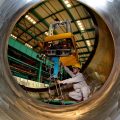
China will develop a new area in the northern region parallel to the Shenzhen Special Economic Zone in the south and the Shanghai Pudong New Area in the east to serve as another economic engine and advance the coordinated development of the Beijing-Tianjin-Hebei region.
The establishment of the Xiongan New Area in Hebei province is a “major historic and strategic choice made by the Communist Party of China Central Committee with Comrade Xi Jinping as the core,” said a circular issued by the CPC Central Committee and the State Council on Saturday.
“It (the decision to set up the new area) is a strategy crucial for a millennium to come,” the circular said.
The area, about 100 km southwest of downtown Beijing, will span three counties that sit at the center of the triangular area formed by Beijing, Tianjin, and Hebei’s provincial capital Shijiazhuang.
The area features geological advantages, convenient transportation, an excellent ecological environment, ample resources and lots of room for development, according to the circular.
The move will help phase out functions from Beijing that are not related to the capital, explore a new model of optimized development in densely populated areas and restructure the urban layout in the Beijing-Tianjin-Hebei region, the circular said.
President Xi, who is also general secretary of the CPC Central Committee, has said that priority should be given to developing an area to pool noncapital functions that will be shifted from Beijing. He has ordered that a modern urban district be built at a suitable location in Hebei, guided by new development concepts.
During an inspection tour to Hebei on Feb 23, Xi called for “world vision, international standards, Chinese characteristics and high goals” in the planning and construction of the new area.
He called for efforts to build Xiongan into “a demonstration area for innovative development”.
The area should prioritize ecological protection and improve people’s well-being as well as protect and carry forward Chinese traditional culture, he said.
Zhao Kezhi, Party chief of Hebei, said on Saturday that the development of such a new area is a historic project that will push forward the integration of the Beijing-Tianjin-Hebei region and accelerate the social and economic growth of Hebei.
Zhao required careful planning of the area. “Construction should not begin until every inch of the area is clearly planned,” he told senior officials in Hebei.
Experts said that the new area bears the double task of becoming a growth pole in northern China and helping cure severe “urban ills”, such as traffic congestion and air pollution in Beijing.
“The new area, together with Beijing and Tianjin, will form a world-class city cluster, and drive the entire economic growth in northern China,” said Xing Tianhe, head of the Urban Planning Association of Hebei.
He said the area, which is now comparatively less developed, offers plenty of room for urban planning and construction. The area is also home to Baiyangdian, northern China’s largest freshwater wetland, so it boasts sound environment conditions.
Li Guoping, head of Peking University’s Beijing Development Institute, said the new area will be the place where Beijing’s noncapital functions will be redistributed to.


